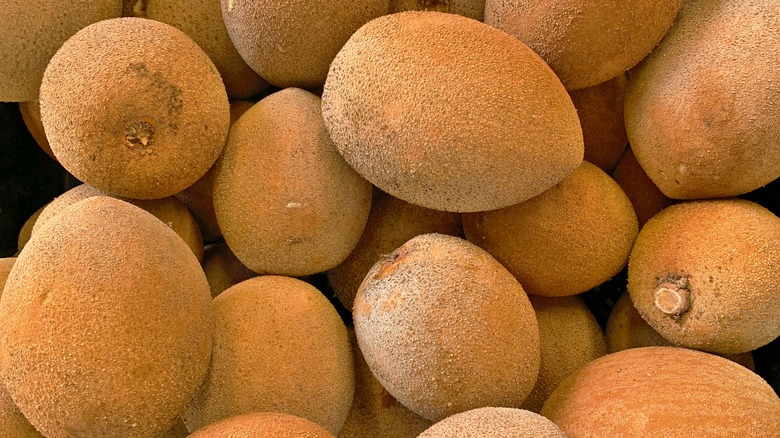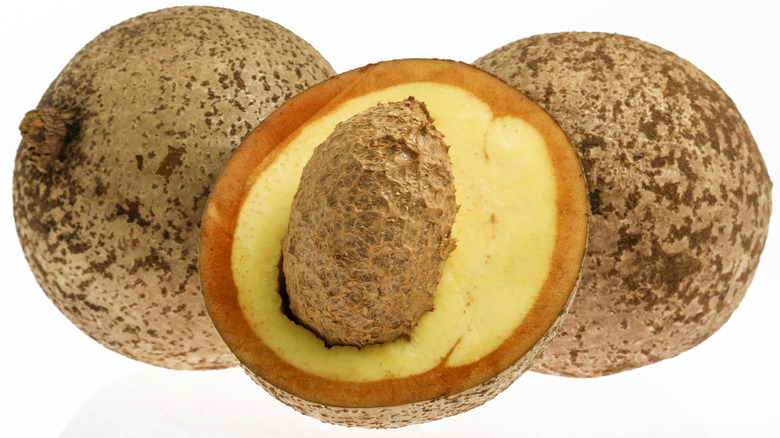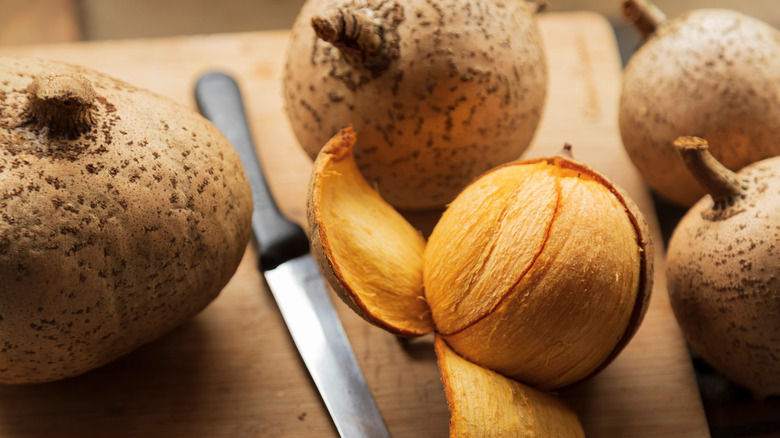Are Mamey Apples Actually Apricots?
The mamey apple has many names — some of you might recognize this brown, egg-shaped fruit as simply "mammee," while its scientific name is Mammea americana. Perhaps you've seen it labeled as St. Domingo apricot, Abricot-pays, or even South American apricot, and mistaken the fruit as a tropical variant of common apricots. But don't be confused by its moniker: Mamey apples are not related to apricots. In fact, they aren't even apples, either.
Both apples and apricots belong to the Rosaceae family in the Rosales order of plants. On the flip side, mamey apples are members of the broader Malpighiales order in the Calophyllaceae family, but were once placed in the Clusiaceae family right alongside mangosteens (the fruit that Queen Victoria is rumored to have loved). Although they've been recategorized, mamey apples are still more botanically similar to mangosteens than apricots or apples.
Another fruit that mamey apples are often mistaken for is the sapote. Sapotes and mamey apples look similar from the outside, and the former is also commonly referred to as a mamey sapote or red mamey, which adds to the confusion. However, these two fruits are also unrelated. Indigenous to the tropical climates of the West Indies and northern areas of South America, mamey apples are a protected species in many parts of the Caribbean. They do grow in the sunny regions of Mexico, Florida, and Hawaii as well, but it's rare to find the fruit thriving anywhere outside of these areas.
What do mamey apples look and taste like?
At first glance, a mamey apple looks much like a coconut or a kiwi. It could even pass as a bambangan, which is a type of savory mango popular in Borneo. Like a bambangan, mamey apples have a grayish-brown peel that is rough, irregular, and covered in scurf (i.e. scaly areas). This skin is thick and bitter (unlike kiwi skin, which is edible), but beneath it is a striking orange-yellow flesh bursting with sweet fragrance. The flesh can be either crisp, firm, and dry, or soft, moist, and juicy — it all depends on how ripe the fruit is. In fact, when ripe, a mamey apple's flesh can have a water content as high as 86%. In general, its pulp is smooth and not very fibrous.
While a mamey apple may not be related to an apricot, its flavor is certainly reminiscent of one: It has a similar subtle floral sweetness with notes of berries and passion fruits. Mamey apples are also similar to mangosteens in this regard, and share the sweet and slightly tangy flavors of their former cousins.
This fruit had seeds inside, but the number will vary depending on its size. Smaller mamey apples can range from seven to 10 centimeters in diameter, whereas others can be as large as 15 to 20 centimeters. Those that fall on the lower end of the spectrum will have one lone seed, but the bigger fruits can have up to four.
How do you eat mamey apples?
A mamey apple can be eaten raw, but don't bite into it without prepping the fruit first. Beneath that woody skin is a fine layer of dry white membrane that's very sharp-tasting and astringent. Make sure to peel the skin and scrape off this film. You'll also want to remove the seeds and slice off the pulp near that area, as it's also quite bitter. From there, dig into your juicy mamey apple as-is or cook it into recipes.
Mamey apple pairs fabulously with fruits like banana and meats like pork and chicken, so consider adding it to salad dressings or one of our mouthwatering sauce recipes, from harissa to sweet chili sauce. The fruit can even be pureed and added to sweet treats like ice creams, pies, and muffins, especially since it pairs well with warm spices, nuts, and whipped cream. Ripe mamey apples don't last for longer than a week or so in the refrigerator, so turning them into preserves is always an option, too.
Interestingly, mamey apples are more than just a source of food in South America and the Caribbean. The fruit is used in native medicine as a treatment for digestive issues, eye-related ailments, and scalp infections. Its seeds are also powdered and used to treat certain skin diseases. Plus, the fruit is packed with vitamin C, vitamin A, and also contains thiamin (vitamin B1), making it nutritious as well as tasty.



